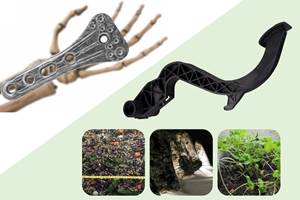Navy unveils unmanned composites-intensive vessel
This entirely new class of ocean-going vessel can traverse thousands of kilometers over the open seas for months at a time, without a single crew member aboard.
Earlier this month, the Defense Advanced Research Projects Agency (DARPA, Washington, DC, US) held a christening ceremony for the technology demonstration vessel it has developed and built through the Agency’s Anti-Submarine Warfare (ASW) Continuous Trail Unmanned Vessel (ACTUV) program. Called the “Sea Hunter,” the 130-foot drone vessel could be used for submarine tracking and countermine activities.
ACTUV is a 130-foot twin-screw trimaran, featuring a fiberglass composite exterior and foam core. The ship is designed for enhanced stability in all kinds of weather. It has a number of unusual features because it does not need to accommodate people. For example, interior spaces are accessible for maintenance but aren’t designed to support a permanent crew.
But of broader technical significance is that ACTUV embodies breakthroughs in autonomous navigational capabilities with the potential to change the nature of U.S. maritime operations, DARPA stated. Through at-sea testing on a surrogate vessel, ACTUV’s autonomy suite has proven capable of operating the ship in compliance with maritime laws and conventions for safe navigation—including International Regulations for Preventing Collisions at Sea, or COLREGS. ACTUV accomplishes this feat through advanced software and hardware that serve as automated lookouts, enabling the ship to operate safely near manned maritime vessels in all weather and traffic conditions, day or night.
ACTUV is designed to normally operate under sparse remote supervisory control but can also serve as a remotely piloted vessel, should the mission or specific circumstances require it. In either case, it would operate at a fraction of the cost of manned vessels that are today deployed for similar missions.
In September 2014, DARPA signed a Memorandum of Agreement (MOA) with the Office of Naval Research to jointly fund an extended test phase of an ACTUV prototype. DARPA will collaborate with ONR to fully test the capabilities of the vessel and several innovative payloads during open-water testing scheduled to begin this summer off the California coast after preliminary checkout and movement to San Diego. Pending the results of those tests, the program could transition to the U.S. Navy by 2018. Leidos (Reston, VA, US) is the company leading the team that built the ACTUV prototype and the construction took place at the Vigor Shipyard in Portland, OR, US.
“What we’ve created together with the Navy is a truck that can carry more payload over greater distances, stay out longer, and be more capable than anything else—and do it highly autonomously because it’s a big vessel and it’s got that flexibility,” said Scott Littlefield, DARPA program manager.
“As the chief mad scientists of the Navy, I say the best ships are partnerships,” said Rear Admiral Mathias Winter, chief of Naval Research, Innovation Technology Requirements and Test & Evaluation (OPNAV N84). “And the partnerships with DARPA, with Leidos, and our entire small, medium and large business base, and our thousands of academics and universities around the world will ensure that the Department of the Navy, the Department of Defense, and this great country and the 310 million Americans that call it home will continue to have the quality of life and the security they need as we continue to field and explore and experiment with capabilities like ACTUV.”
Here are highlights from on-water speed tests:
Related Content
Bioabsorbable and degradable glass fibers, compostable composite parts
ABM Composite offers sustainable options and up to a 60% reduction in carbon footprint for glass fiber-reinforced composites.
Read MoreNovel dry tape for liquid molded composites
MTorres seeks to enable next-gen aircraft and open new markets for composites with low-cost, high-permeability tapes and versatile, high-speed production lines.
Read MoreCirculinQ: Glass fiber, recycled plastic turn paving into climate solutions
Durable, modular paving system from recycled composite filters, collects, infiltrates stormwater to reduce flooding and recharge local aquifers.
Read MoreOne-shot manufacture of 3D knitted hybrid thermoplastic composite structures
MAPICC 3D project replaces steel seat support in heavy-duty vehicle with a 3D knitted composite made from thermoplastic hybrid yarns comprising the matrix and reinforcing components.
Read MoreRead Next
Combining multifunctional thermoplastic composites, additive manufacturing for next-gen airframe structures
The DOMMINIO project combines AFP with 3D printed gyroid cores, embedded SHM sensors and smart materials for induction-driven disassembly of parts at end of life.
Read MorePlant tour: Teijin Carbon America Inc., Greenwood, S.C., U.S.
In 2018, Teijin broke ground on a facility that is reportedly the largest capacity carbon fiber line currently in existence. The line has been fully functional for nearly two years and has plenty of room for expansion.
Read More“Structured air” TPS safeguards composite structures
Powered by an 85% air/15% pure polyimide aerogel, Blueshift’s novel material system protects structures during transient thermal events from -200°C to beyond 2400°C for rockets, battery boxes and more.
Read More













.jpg;maxWidth=300;quality=90)












